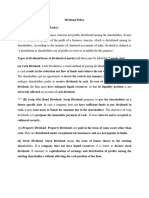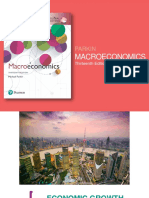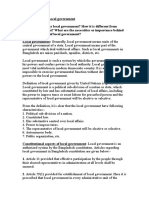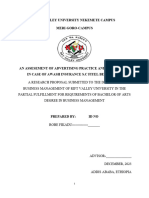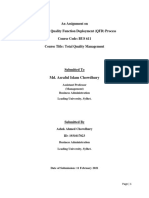0 ratings0% found this document useful (0 votes)
34 viewsDividend Policy: Principles & Applications
Dividend Policy: Principles & Applications
Uploaded by
cuteserese roseCopyright:
© All Rights Reserved
Available Formats
Download as PDF, TXT or read online from Scribd
Dividend Policy: Principles & Applications
Dividend Policy: Principles & Applications
Uploaded by
cuteserese rose0 ratings0% found this document useful (0 votes)
34 views46 pagesOriginal Title
Chapter 5
Copyright
© © All Rights Reserved
Available Formats
PDF, TXT or read online from Scribd
Share this document
Did you find this document useful?
Is this content inappropriate?
Copyright:
© All Rights Reserved
Available Formats
Download as PDF, TXT or read online from Scribd
Download as pdf or txt
0 ratings0% found this document useful (0 votes)
34 views46 pagesDividend Policy: Principles & Applications
Dividend Policy: Principles & Applications
Uploaded by
cuteserese roseCopyright:
© All Rights Reserved
Available Formats
Download as PDF, TXT or read online from Scribd
Download as pdf or txt
You are on page 1of 46
Financial Management:
Principles & Applications
Thirteenth Edition
Chapter 16
Dividend Policy
Copyright © 2018, 2014, 2011 Pearson Education,
Copyright © 2018, Inc.Education,
2014, 2011 Pearson All Rights Reserved
Inc. All Rights Reserved
Slide Contents
• Learning Objectives
• Principles Applied in This Chapter
1. How Do Firms Distribute Cash to Their
Shareholders?
2. Does Dividend Policy Matter?
3. Cash Distribution Policies in Practice
Copyright ©2014 Pearson Education, Inc. All rights reserved. 16-2
Learning Objectives
1. Distinguish between the use of cash
dividends and share repurchases.
2. Understand the tax treatments of
dividends and capital gains, and stock
dividends and stock splits, and the
conditions under which dividend policy is
an important determinant of stock value.
3. Describe corporate dividend policies that
are commonly used in practice.
Copyright ©2014 Pearson Education, Inc. All rights reserved. 16-3
Introduction
When a firm generates cash from operations,
what can the firm do with the cash?
1. Use the cash to fund new investments,
2. Use the cash to pay off some of the firm’s
debt, and/or
3. Distribute the cash back to the firm’s
shareholders either as a cash dividend or as
stock repurchases.
Copyright ©2014 Pearson Education, Inc. All rights reserved. 16-4
Introduction (cont.)
This chapter provides answers to three questions
regarding a firm’s dividend policy:
1. What are the pros and cons of the methods the
firm can use to distribute cash?
2. Why should the firm’s shareholders care about
the firm’s dividend policy given that they can
generate cash when they need it by selling
some of their shares?
3. What cash distribution policies do most firms
use in practice?
Copyright ©2014 Pearson Education, Inc. All rights reserved. 16-5
16.1 HOW DO FIRMS
DISTRIBUTE CASH TO THEIR
SHAREHOLDERS?
Copyright ©2014 Pearson Education, Inc. All rights reserved. 16-6
How Do Firms Distribute Cash to
their Shareholders?
Cash distributions can take two basic forms:
1. Cash dividend - cash is paid directly to
the shareholders.
2. Share repurchase - a company uses cash
to buy back its own shares from the market
place, thereby reducing the number of
outstanding shares.
Copyright ©2014 Pearson Education, Inc. All rights reserved. 16-7
How Do Firms Distribute Cash to
their Shareholders? (cont.)
The impact on the balance sheet will be as
follows:
– Assets side - cash will be reduced due to cash
dividend or share repurchase.
– Equity side - there will be a corresponding
decrease.
Copyright ©2014 Pearson Education, Inc. All rights reserved. 16-8
Figure 16.1 Historical Distributions to
Shareholders through Dividends and Share
Repurchases
Copyright ©2014 Pearson Education, Inc. All rights reserved. 16-9
Cash Dividends
A firm’s dividend policy determines how
much cash it will distribute to its shareholders
and when these distributions will be made.
Dividend policy has two main attributes:
– dividend payout ratio, and
– the pattern of dividends followed over
time.
Copyright ©2014 Pearson Education, Inc. All rights reserved. 16-10
Dividend Payment Procedures
Date Explanation Calendar Date
Announcement Dividend is declared. March 15
Date
Ex-Dividend Date Shares begin trading May 17
ex-dividend.
Record Date Dividend will be paid May 19
to shareholders who
own the stock on this
date.
Payment Date Dividends are May 27
distributed to the
shareholders of
record on the record
date.
Copyright ©2014 Pearson Education, Inc. All rights reserved. 16-11
Stock Repurchases (Stock Buyback)
Stock repurchase is when a firm uses its
cash to repurchase some of its own stock.
This results in a reduction in the firm’s cash
balance as well as the number of shares of
stock outstanding.
Copyright ©2014 Pearson Education, Inc. All rights reserved. 16-12
How do Firms Repurchase Their
Shares?
• Open Market Repurchase - Here the firm
acquires the stock on the market, often
buying a relatively small number of shares
everyday. Most common.
• Tender Offer - Here the company makes a
formal offer to buy a large specified number
of shares at a stated price. The price is set
above the market price to attract sellers.
Copyright ©2014 Pearson Education, Inc. All rights reserved. 16-13
How do Firms Repurchase Their
Shares? (cont.)
Direct Purchase from a large investor -
Here the firm purchases the stock from one
or more major stockholders on a negotiated
basis. This method is not used frequently.
Copyright ©2014 Pearson Education, Inc. All rights reserved. 16-14
Non-Cash Distributions: Stock
Dividends and Stock Splits
• A stock dividend is a pro-rata distribution
of additional shares of stock to the firm’s
current stockholders.
• Stock split is essentially a very large stock
dividend.
Copyright ©2014 Pearson Education, Inc. All rights reserved. 16-15
Rationale for a Stock Dividend or
Split
One rationale is that there is an optimal
trading price range for the firm’s stock. If
the price exceeds that optimal range, it can
be brought back to the optimal range by
doing a stock split or paying stock dividend.
Copyright ©2014 Pearson Education, Inc. All rights reserved. 16-16
16.2 DOES DIVIDEND POLICY
MATTER?
Copyright ©2014 Pearson Education, Inc. All rights reserved. 16-17
Does Dividend Policy Matter?
• Modigiliani and Miller suggest that without
taxes and transaction costs, cash dividends
and share repurchases are equivalent and
the timing of the distribution is
unimportant.
• This is known as the Modigiliani and Miller
dividend irrelevancy proposition.
Copyright ©2014 Pearson Education, Inc. All rights reserved. 16-18
The Irrelevance of the Distribution
Choice
The distribution choice is irrelevant under the
following conditions or assumptions:
1. There are no taxes.
2. No transaction costs are incurred in either
buying or selling shares of stock.
3. The firm’s operating and investment policies
are fixed.
Copyright ©2014 Pearson Education, Inc. All rights reserved. 16-19
The Irrelevance of the Distribution
Choice (cont.)
The dividend irrelevancy proposition can be
illustrated in two ways:
1. Timing of dividend distributions does not affect
firm value.
2. In the absence of taxes and transaction costs,
a cash dividend is equivalent to a share
repurchase.
Copyright ©2014 Pearson Education, Inc. All rights reserved. 16-20
Figure 16.2 Dividend Policy Choices
Faced by Clinton Enterprises
Copyright ©2014 Pearson Education, Inc. All rights reserved. 16-21
Figure 16.2 Dividend Policy Choices
Faced by Clinton Enterprises (cont.)
Copyright ©2014 Pearson Education, Inc. All rights reserved. 16-22
The Timing of Dividend is Irrelevant
(cont.)
Figure 16-2 considers two alternatives:
1. Pay $35M now and $135M in one year
2. Pay $52.5M now and $114.875M in one year
• In both cases, the value of share remains
the same at $15.24 per share.
Copyright ©2014 Pearson Education, Inc. All rights reserved. 16-23
CHECKPOINT 16.1:
CHECK YOURSELF
Stock Price and the Timing of Dividend
Payments
Copyright ©2014 Pearson Education, Inc. All rights reserved. 16-24
The Problem
Consider Alternative #3 in which Northwest Wire and
Cable decides to increase its current period dividend
to only $8 million. Show that the firm’s equity under
this scenario would be $30.79 million.
Copyright ©2014 Pearson Education, Inc. All rights reserved. 16-25
Step 1: Picture the Problem
The firm is considering two alternatives:
– Pay $4 million today and $30million in year 1 as
liquidating dividend; or
– Pay $12 million today and pay $21.04 in year 1
($30 million - $8million*1.12 paid to new
shareholders)
Copyright ©2014 Pearson Education, Inc. All rights reserved. 16-26
Step 2: Decide on a Solution
Strategy
The value of Northwest Wire and Cable
company’s equity is equal to the present
value of the firm’s expected cash dividends.
We can estimate the value using equation 16-
1.
Copyright ©2014 Pearson Education, Inc. All rights reserved. 16-27
Step 3: Solve
Value – Alternative 1
Value = $4 million + $30 million /(1.12)1
Value = $30.79 million
Copyright ©2014 Pearson Education, Inc. All rights reserved. 16-28
Step 3: Solve (cont.)
Value – Alternative 2
Value = $12 million + $21.04 million /(1.12)1
Value = $30.79 million
Copyright ©2014 Pearson Education, Inc. All rights reserved. 16-29
Step 4: Analyze
• This example illustrates that the timing of
dividend payment does not affect the value
of the firm.
• This was true because we held constant the
firm’s investment cash flows. We also
assumed that the new shares could be
issued under the same terms as the
existing shares.
Copyright ©2014 Pearson Education, Inc. All rights reserved. 16-30
The form of Payment (Cash Dividend
Versus Share Repurchase) is Irrelevant
Table 16-1 illustrates two possibilities for the
use of $1,000,000 in cash flows:
1. A $1,000,000 cash dividend.
2. A $1,000,000 stock repurchase.
• It is observed that the value is the same so
an investor will be indifferent between the
two options.
Copyright ©2014 Pearson Education, Inc. All rights reserved. 16-31
Table 16.1 Wealth Effects of Cash Distributions:
Dividends and Share Repurchases
Copyright ©2014 Pearson Education, Inc. All rights reserved. 16-32
Individual Wealth Effects:
Personal Taxes
What are the tax rules with regard to
dividends and share repurchases?
1. 100% of cash dividends are taxable in the year
in which they are received.
2. When individuals sell shares, tax is assessed
only on the capital gain.
3. If investor does not sell the shares to the
company making stock repurchase, there will
be no taxable gain.
Copyright ©2014 Pearson Education, Inc. All rights reserved. 16-33
Why Dividend Policy is Important?
Transactions are costly
– Since taxes are incurred when dividends are
received and transactions costs are incurred
when buying and selling shares, investors will
prefer to select companies whose dividend policy
match up with their own preferences. Because
firms with different dividends attract different
dividend clienteles, it is important that
dividend policy remain somewhat stable.
Copyright ©2014 Pearson Education, Inc. All rights reserved. 16-34
Why Dividend Policy is Important?
(cont.)
The Information Conveyed by Dividend and
Share Repurchase Announcement
– Information can affect future valuation.
– Firms tend to increase their dividends when
dividends can be sustained in the future. In
such cases, dividend increase is clearly good
news.
Copyright ©2014 Pearson Education, Inc. All rights reserved. 16-35
Why Dividend Policy is Important?
(cont.)
Share repurchases are also viewed very
favorably as it reveals that:
– the firm has generated more money than it
currently needs, and/or
– the equity is currently underpriced.
Copyright ©2014 Pearson Education, Inc. All rights reserved. 16-36
Why Dividend Policy is Important?
(cont.)
The Information Conveyed by Stock
Dividends and Stock Splits
– The announcement of stock dividends and stock
splits tend to generate positive stock returns.
Some have suggested that firms have a
preferred trading range and stock splits help
bring stock prices to that trading range.
Copyright ©2014 Pearson Education, Inc. All rights reserved. 16-37
16.3 CASH DISTRIBUTION
POLICIES IN PRACTICE
Copyright ©2014 Pearson Education, Inc. All rights reserved. 16-38
Cash Distribution Policies in Practice
Stable Payout
In a survey of CEOs, most CEOs recognized the
importance of maintaining consistency and
stability in dividend policy (see figure 16.3)
Copyright ©2014 Pearson Education, Inc. All rights reserved. 16-39
Figure 16.3 Survey of CFO Opinions
Regarding Dividend Policy Issues
Copyright ©2014 Pearson Education, Inc. All rights reserved. 16-40
Figure 16.3 Survey of CFO Opinions
Regarding Dividend Policy Issues
Copyright ©2014 Pearson Education, Inc. All rights reserved. 16-41
Cash Distribution Policies in Practice
(cont.)
• Figure 16-4 reveals that stock repurchase
decisions are driven by executive’s feeling
that the stock is a good investment relative
to its true value and that there are a lack of
good investment opportunities to invest in.
• Table 16.3 summarizes the views of
financial executives about payout policy.
Copyright ©2014 Pearson Education, Inc. All rights reserved. 16-42
Figure 16.4 Factors Important to Your
Company’s Repurchase Decision
Copyright ©2014 Pearson Education, Inc. All rights reserved. 16-43
Table 16.3 Summary of Financial
Executives’ Views about Payout Policy
Copyright ©2014 Pearson Education, Inc. All rights reserved. 16-44
Residual Dividend Policy
With a residual dividend policy, the firm first
finances its investments using its own
earnings. Dividends are paid out of the
residual earnings that are not needed to
finance new investment opportunities.
Copyright ©2014 Pearson Education, Inc. All rights reserved. 16-45
Other Factors Playing a Role in
How Much to Distribute
• Liquidity Position
• Lack of Other Sources of Financing
• Earnings Predictability
Copyright ©2014 Pearson Education, Inc. All rights reserved. 16-46
You might also like
- Dissertation Proposal Example 1000 WordsDocument7 pagesDissertation Proposal Example 1000 WordsCustomWrittenPapersCanada100% (1)
- Global Talent Management at NovartisDocument10 pagesGlobal Talent Management at Novartisabhishek majiNo ratings yet
- Marvel Case SolutionsDocument3 pagesMarvel Case Solutionsmayur7894No ratings yet
- Letter of Offer Jomari Sinaban 12023189 V2Document20 pagesLetter of Offer Jomari Sinaban 12023189 V2Jomari SinabanNo ratings yet
- Titman CH 16 - Dividend PolicyDocument55 pagesTitman CH 16 - Dividend PolicyIKA RAHMAWATINo ratings yet
- 14 Zutter Smart MFBrief 15e ch14Document69 pages14 Zutter Smart MFBrief 15e ch14My videos My videoNo ratings yet
- Ch. 14 Gitman 14eDocument65 pagesCh. 14 Gitman 14eisfi23001No ratings yet
- M14 Gitman50803X 14 MF AC14Document70 pagesM14 Gitman50803X 14 MF AC14Joan Marie100% (2)
- Gitman Chapter 14 Divident PolicyDocument59 pagesGitman Chapter 14 Divident PolicyArif SharifNo ratings yet
- Dividend, Dividend Policy: Course: FINC6001 Effective Period: September2019Document74 pagesDividend, Dividend Policy: Course: FINC6001 Effective Period: September2019salsabilla rpNo ratings yet
- Chapter 14 - Dividend PolicyDocument38 pagesChapter 14 - Dividend PolicyRAQAEL RHODENo ratings yet
- Payout Policy RevisedDocument69 pagesPayout Policy RevisedThenappan GanesenNo ratings yet
- Chap14 Dividend Payout PolicyDocument62 pagesChap14 Dividend Payout PolicyBaby KhorNo ratings yet
- Part 8 Dividend PolicyDocument53 pagesPart 8 Dividend PolicyAliaa HabibNo ratings yet
- 2.8. Pay Out PolicyDocument23 pages2.8. Pay Out Policyaprilia wahyu perdaniNo ratings yet
- Getting Started - Principles of FinanceDocument32 pagesGetting Started - Principles of FinancehoneyschuNo ratings yet
- Chapter 1aDocument33 pagesChapter 1aVasunNo ratings yet
- Power Point For Dividend PolicyDocument51 pagesPower Point For Dividend PolicyAnonymous DStKlFbQ1B100% (1)
- Week 12 - Introduction To Dividend PolicyDocument9 pagesWeek 12 - Introduction To Dividend PolicyJoshua NemiNo ratings yet
- LN10Titman 449327 12 LN10Document57 pagesLN10Titman 449327 12 LN10mehmetgungormusNo ratings yet
- Review Q's Chap 14Document3 pagesReview Q's Chap 14Katrina PaquizNo ratings yet
- 12a Dividend PolicyDocument7 pages12a Dividend PolicyCharlesNo ratings yet
- L8 Mmi 08 Bma 16 Dividend PolicyDocument26 pagesL8 Mmi 08 Bma 16 Dividend PolicychooisinNo ratings yet
- Topic 4Document22 pagesTopic 4DonNo ratings yet
- Dividend Policies and DecisionsDocument19 pagesDividend Policies and DecisionsGrace NdanuNo ratings yet
- CF Week13 14 STDocument42 pagesCF Week13 14 STPol 馬魄 MattostarNo ratings yet
- Dividend Policies and DecisionsDocument19 pagesDividend Policies and Decisionsdushime delphineNo ratings yet
- LN01Titman 449327 12 LN01Document39 pagesLN01Titman 449327 12 LN01mehmetgungormusNo ratings yet
- 17 - Dividend PolicyDocument25 pages17 - Dividend Policyrithwikmd26No ratings yet
- Financial Management:: Stock ValuationDocument57 pagesFinancial Management:: Stock ValuationSarah SaluquenNo ratings yet
- FM-Sessions 23 - 24 Dividend Policy-CompleteDocument72 pagesFM-Sessions 23 - 24 Dividend Policy-CompleteSaadat ShaikhNo ratings yet
- FM II, Chapter 2, A Review of Dividends and Dividends PolicyDocument63 pagesFM II, Chapter 2, A Review of Dividends and Dividends PolicyibsaashekaNo ratings yet
- Distributions To Shareholders:: Dividends and Share RepurchasesDocument45 pagesDistributions To Shareholders:: Dividends and Share RepurchasesMaira DogarNo ratings yet
- Bcom Sem6 Dividend DecisionDocument48 pagesBcom Sem6 Dividend Decisiontoji01313No ratings yet
- Dividend Policy Decisions NotesDocument11 pagesDividend Policy Decisions NotesMIRADOR ACCOUNTANTS KENYANo ratings yet
- Devidend PolicyDocument138 pagesDevidend PolicyYusuph HajiNo ratings yet
- Chapter 1brooks - 3e - PPT - 01Document33 pagesChapter 1brooks - 3e - PPT - 01Maryam AlaleeliNo ratings yet
- DIVIDEND POLICIES AND DECISIONS notesDocument10 pagesDIVIDEND POLICIES AND DECISIONS notescorneliuscheruiyot353No ratings yet
- Payout PolicyDocument41 pagesPayout PolicyCFANo ratings yet
- Dividend PolicyDocument15 pagesDividend PolicyhunterayskaumeNo ratings yet
- Dividend PolicyDocument12 pagesDividend Policyarshiyakhanum659No ratings yet
- Financial Planning Control and ForecastDocument20 pagesFinancial Planning Control and ForecastvivienNo ratings yet
- Report No. 10 - Dividend PolicyDocument45 pagesReport No. 10 - Dividend Policyhendrix obcianaNo ratings yet
- Chapter 1 - Financial ManagementDocument32 pagesChapter 1 - Financial ManagementtheputeriizzahNo ratings yet
- Chapter 10 (Stock Valuation) ClassDocument58 pagesChapter 10 (Stock Valuation) ClasswstNo ratings yet
- Titman PPT CH10Document58 pagesTitman PPT CH10Sayyaf NayefNo ratings yet
- Ch 1 Dividend Policy and Theories EdiiiiDocument11 pagesCh 1 Dividend Policy and Theories Ediiiiabdurehmanhirpho1No ratings yet
- LN01Titman - Principles of Finance IDNDocument49 pagesLN01Titman - Principles of Finance IDNJessica SihiteNo ratings yet
- FM II Chapter 1Document23 pagesFM II Chapter 1Amanuel AbebawNo ratings yet
- FM II CH 1,2 and 3Document104 pagesFM II CH 1,2 and 3Andualem ZenebeNo ratings yet
- FM II SlidesDocument119 pagesFM II SlidesYasinNo ratings yet
- Finance Term Paper (Ratio Analysis)Document13 pagesFinance Term Paper (Ratio Analysis)UtshoNo ratings yet
- FIN41520 - Group Assigment - Crenna Chantal & Kavdia ChiragDocument10 pagesFIN41520 - Group Assigment - Crenna Chantal & Kavdia ChiragChirag KavdiaNo ratings yet
- Unit 4Document19 pagesUnit 4aryachaudhari765No ratings yet
- Assignment #2 Dividend and Dividend PolicyDocument2 pagesAssignment #2 Dividend and Dividend Policybereketliranso184No ratings yet
- Orion PharmaDocument20 pagesOrion PharmaShamsun NaharNo ratings yet
- Dividend PolicyDocument35 pagesDividend PolicyVic100% (3)
- Dividend Policy: Updated VersionDocument30 pagesDividend Policy: Updated VersionYogeshwar DwivediNo ratings yet
- A Study On Dividend PolicyDocument75 pagesA Study On Dividend PolicyVeera Bhadra Chary ChNo ratings yet
- Chapter 4 Dividend DecisionsDocument6 pagesChapter 4 Dividend Decisionssanthosh kumaranNo ratings yet
- Dividend Is The Portion of Earnings Available To Equity Shareholders That Equally (Per Share Bias) Is Distributed Among The ShareholdersDocument21 pagesDividend Is The Portion of Earnings Available To Equity Shareholders That Equally (Per Share Bias) Is Distributed Among The ShareholdersKusum YadavNo ratings yet
- DividendsDocument8 pagesDividendsNtege SimonNo ratings yet
- Dividend Growth Investing: A Step-by-Step Guide to Building a Dividend Portfolio for Early RetirementFrom EverandDividend Growth Investing: A Step-by-Step Guide to Building a Dividend Portfolio for Early RetirementRating: 4 out of 5 stars4/5 (1)
- Kapoor PF 13e PPT Ch010Document32 pagesKapoor PF 13e PPT Ch010cuteserese roseNo ratings yet
- Kapoor PF 13e PPT Ch012Document36 pagesKapoor PF 13e PPT Ch012cuteserese roseNo ratings yet
- Jeko 53 (3) - 4Document15 pagesJeko 53 (3) - 4cuteserese roseNo ratings yet
- Chapter 7 IFDocument49 pagesChapter 7 IFcuteserese roseNo ratings yet
- Kapoor PF 13e PPT Ch009Document39 pagesKapoor PF 13e PPT Ch009cuteserese roseNo ratings yet
- Chapter 10 IFDocument25 pagesChapter 10 IFcuteserese roseNo ratings yet
- Chapter 9 IFDocument64 pagesChapter 9 IFcuteserese roseNo ratings yet
- Chapter 11 IFDocument42 pagesChapter 11 IFcuteserese roseNo ratings yet
- Chapter 3 IFDocument35 pagesChapter 3 IFcuteserese roseNo ratings yet
- Chapter 6 IFDocument44 pagesChapter 6 IFcuteserese roseNo ratings yet
- Chapter 16 IfDocument47 pagesChapter 16 Ifcuteserese roseNo ratings yet
- Chapter 1 IFDocument43 pagesChapter 1 IFcuteserese roseNo ratings yet
- Chapter 5 IFDocument48 pagesChapter 5 IFcuteserese roseNo ratings yet
- CHP 1 NTRO ADVANCED FINANCIAL MANAGEMENTDocument4 pagesCHP 1 NTRO ADVANCED FINANCIAL MANAGEMENTcuteserese roseNo ratings yet
- Chapter 7Document33 pagesChapter 7cuteserese roseNo ratings yet
- Chapter 2 IFDocument39 pagesChapter 2 IFcuteserese roseNo ratings yet
- Chapter02 Updated PDFDocument39 pagesChapter02 Updated PDFcuteserese roseNo ratings yet
- Lecture 6 Saving and Investment (Student)Document39 pagesLecture 6 Saving and Investment (Student)cuteserese roseNo ratings yet
- Lecture 5 Economic Growth (Student)Document32 pagesLecture 5 Economic Growth (Student)cuteserese roseNo ratings yet
- Lecture 2 Gross Domestic Product (Student)Document59 pagesLecture 2 Gross Domestic Product (Student)cuteserese roseNo ratings yet
- Lecture 3 and 4 Unemployment and Inflation (Student)Document54 pagesLecture 3 and 4 Unemployment and Inflation (Student)cuteserese roseNo ratings yet
- Chapter 1 Lecture Presentation (Student)Document39 pagesChapter 1 Lecture Presentation (Student)cuteserese roseNo ratings yet
- Guidelines For Effective Strategic ManagementDocument1 pageGuidelines For Effective Strategic Managementcuteserese roseNo ratings yet
- 6 Internal Audit1Document23 pages6 Internal Audit1cuteserese roseNo ratings yet
- Social Media and Business Communication 1Document15 pagesSocial Media and Business Communication 1Umme HafsaNo ratings yet
- Global ProcurementDocument11 pagesGlobal ProcurementVan ThaiNo ratings yet
- Midterm Exam Practice TestDocument16 pagesMidterm Exam Practice TestAldous RenielNo ratings yet
- Riel Corporation Comparative Statements of Financial Position December 31, 2015Document2 pagesRiel Corporation Comparative Statements of Financial Position December 31, 2015Rocel DomingoNo ratings yet
- Tax Study Material PDFDocument151 pagesTax Study Material PDFROHITH R MENONNo ratings yet
- SPA ProcessDocument28 pagesSPA ProcessJeffrey PolisticoNo ratings yet
- Nirakka 2Document9 pagesNirakka 2莫愁No ratings yet
- 24.catalogue Breather-Cat-18-In-PowerDocument39 pages24.catalogue Breather-Cat-18-In-PowerAngel StragliatiNo ratings yet
- ECR CHLN May-2023Document1 pageECR CHLN May-2023Pradeep SaraswatNo ratings yet
- Grade 10 (Edexcel) Economics IDocument13 pagesGrade 10 (Edexcel) Economics IKeven MothaNo ratings yet
- Digital PaymentsDocument7 pagesDigital Paymentspragya pathakNo ratings yet
- Business EnviromentDocument9 pagesBusiness EnviromentSimona AlexandruNo ratings yet
- Fundamental Analysis of Public Sector Banks in India (SBI)Document81 pagesFundamental Analysis of Public Sector Banks in India (SBI)Meraj Ansari60% (5)
- Financial Accounting Management Accounting Primary Users Purpose of InformationDocument3 pagesFinancial Accounting Management Accounting Primary Users Purpose of Informationpanda 1No ratings yet
- Amruta Sachin Kamble (CV - Resume)Document1 pageAmruta Sachin Kamble (CV - Resume)hady mohsinNo ratings yet
- Globalisation Effect Globalisation in Indian Economy Advantages Impact Debate FaqsDocument5 pagesGlobalisation Effect Globalisation in Indian Economy Advantages Impact Debate Faqssridharvchinni_21769No ratings yet
- Superior Court of Justice Ruling On Proposed Hiawatha First Nation Gas StationDocument10 pagesSuperior Court of Justice Ruling On Proposed Hiawatha First Nation Gas StationPeterborough ExaminerNo ratings yet
- Local GovernmentDocument4 pagesLocal GovernmentBM Ariful Islam100% (1)
- Robe ProposalDocument30 pagesRobe Proposalmagarsa hirphaNo ratings yet
- "How To Create A Hit Format in 10 Lessons": The Definitive GuideDocument43 pages"How To Create A Hit Format in 10 Lessons": The Definitive GuideSefaradies Buenos AiresNo ratings yet
- Employees Quality Function Deployment (QFD) ProcessDocument9 pagesEmployees Quality Function Deployment (QFD) ProcessAhmed SojibNo ratings yet
- MPPL 5 Project Integration ManagementDocument41 pagesMPPL 5 Project Integration ManagementFirman AuliaNo ratings yet
- Managing Business MeetingDocument3 pagesManaging Business MeetingAba BekymosNo ratings yet
- By Dale A Gulden, Solar Direct CEODocument22 pagesBy Dale A Gulden, Solar Direct CEOAbdulkhadir Suhair100% (1)
- 218.328 Assignment 2 Contract Review - 2023Document2 pages218.328 Assignment 2 Contract Review - 2023Michael FuNo ratings yet
- Cta 1D CV 09907 D 2023apr19 RefDocument15 pagesCta 1D CV 09907 D 2023apr19 RefFirenze PHNo ratings yet








































